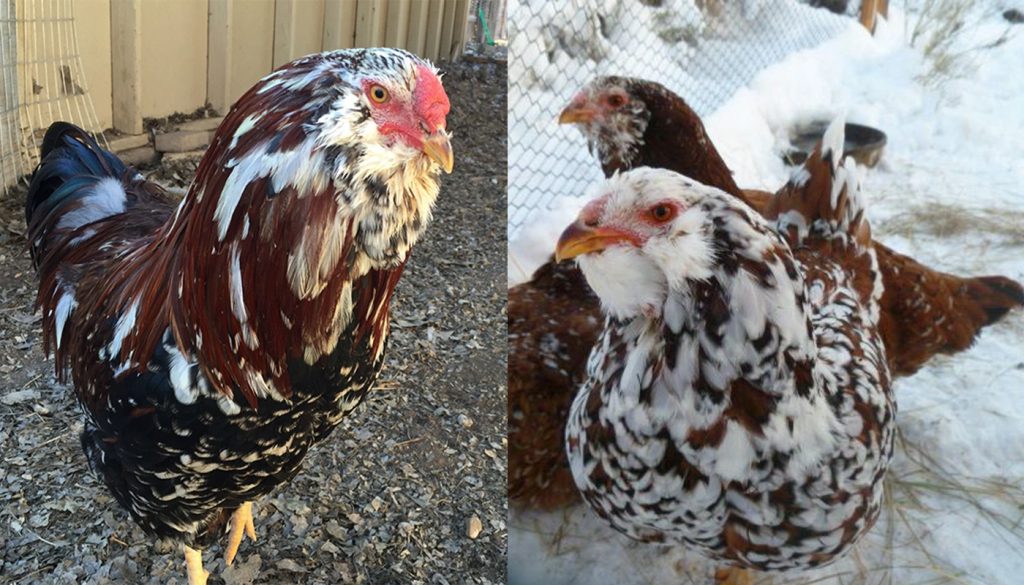
The Orloff is a calm, gentle and friendly dual-purpose chicken. It is easy to handle, does not require much to upkeep and is one of the most wonderful chicken breeds around.
As they are quite rare, especially in the USA, these lovely birds are in need of breeders to promote them and keep them from disappearing from the USA for good. They are listed by the American Livestock Conservancy as a rare endangered breed.
There is said to be quite tasty and some have called it a bit gamey but makes a good roaster. They will also lay a fair amount of medium white eggs for the breakfast table of between two-three a week per hen. They are able to endure extreme cold conditions their small combs not susceptible to frostbite and their fat bodies keeping them cosy. Apart from being a dual purpose they will add a unique quality to your flock and make a great pet chicken.
| Country of Origin: | Russia/Persia |
| American Poultry Association: | No – They are not a recognized as a breed of chicken in the United States The Orloff was once admitted to the Standard of Perfection by the American Poultry Association but was taken removed because there was not much interest in the Breed in America. |
| Chicken Category: | Large Breed |
| Chicken Class: | Not Classified |
| Bantam Variety Available? | Yes – Other Comb Clean Legged Bantam Classification |
| Related | TOP 10 BANTAM CHICKEN BREEDS FOR BEGINNERS |
| Good Starter Chicken? | Yes, although they are rare, these gentle calm chickens make a good starter chicken. |
| Related | 10 BEST STARTER CHICKENS FOR THE FIRST TIME POULTRY KEEPER |
IDENTIFICATION⇒ |
Appearance/Body: These exotic birds have a long neck, round head, full muffs and beards. They have heavy eyelids, dark eyes, small walnut combs. Their legs are clean and yellow with 4 toes.
Color(s) Black, White, Mahogany, Cuckoo, Black-tailed Red and Spangled
Comb: They have a walnut comb
Ave. Weight: Pullet: 4.5 lbs.
Hens: 6 lbs. Cockerel: 6 lbs. Rooster: 7 lbs. |
PURPOSE⇒ |
Eggs: They are not very good egg layers.
They lay medium sized light brown eggs They lay 90 – 100 eggs per year They will lay throughout the year with more prolific laying during the winter months They start to lay eggs from around 24 weeks old.
Meat:They have white skin
They were developed as a table bird and make good rosters
Breeding: They are not too difficult to breed but there are a limited number of breeders in the USA. Incubators or brood hens will be required to hatch and foster the chicks.
The hens do not get broody They do not make good brood hens They do not sit on their eggs They will raise their chicks and make fairly good mothers.
Show Bird: As they are not a popular breed in the USA they are not really a good show bird
Pets: Their friendly nature and intelligence makes them delightful pets
Other: Orloff adds a unique quality to any backyard flock.
|
CHARACTERISTICS |
|
|---|---|
| Life Expectancy: | The average lifespan is 6 – 8 years |
| Health: | They do not have many known health issues |
| You may Also Like: | HOW TO TELL IS A CHICKEN IS SICK |
| Temperament: | Calm, friendly, active and intelligent |
| Flyers? | They can fly |
| Noisy Birds? | They are quiet birds |
| Interaction with other chickens: | They will interact with other chickens/breeds quite calmly |
| Good with kids? | They are okay around supervised children | Related | 10 ROOSTER BREEDS THAT DO NOT MIND CHILDREN |
| Socialize Behavior? | They tend to shy away from other domestic animals preferring the company of their own or other chicken breeds. |
| You may Also Like: | HOW TO SOCIALIZING YOUR NEW CHICKENS |
| Known predators: | Always keep an eye on domestic pets such as dogs and cats. If hawks and or foxes are in your area it is always best to take precautions. Check with local animal shelters, zoos, vets, animal control and or pet stores about common predators in your area. |
| Conservation Status: | These birds conservation status is recorded as “critical” |
IDEAL ENVIRONMENT |
|
|---|---|
| Garden Size: | They do well in confinement but do like to free range and adapt to most garden sizes. |
| Ideal Climate: | They are extremely cold hardy but do not take too well to extreme heat. |
| Ideal Coop: | The rule of thumb for any coop is 50 cm x 50 cm per hen/rooster in the coop. Ensure there is a good space for the nesting boxes and nightly roosting rails at least 1.5 inches wide. Good ventilation for air but not too drafty especially in winter. It is always a good idea to raise the coop off the ground to give the birds a dry place to roost and lay especially in wet weather. |
| Ideal Coop Run: | As they can fly and will if necessary it is best to completely cover the coop run. |
| Ideal Flock Size: | They do like to socialize with other chickens and are happy in any size flock. |
| Special Instructions: | They do not have any special instructions. |
| Accessories: | The following accessories are ideal for your coop: Nesting boxes Straw for the boxes and roosting area Roosting rails Perches Water troughs/bowls Food bowls/feeders Heating lamp(s) Animal carrier for transport purposes |
| You may Also Like: | 45 FREE DIY CHICKEN COOP PLANS, TUTORIALS AND DESIGNS |
WHERE TO BUY THEM |
|
|---|---|
| Live Poultry Outlets: | As an extremely rare breed in the USA it is doubtful that one will find these birds at live poultry outlets, or poultry farms. Greenfire Farms in the USA has been known to breed Orloff chickens. |
| Internet Poultry Websites: | Orloff is not really a chicken breed that one will find on an internet site except for farms such as Greenfire Farms as mentioned above. |
| Organizations: | The American Livestock Conservancy may be able to help with advice on breeding, keeping or even importing eggs to breed these chickens in the USA. They may also be able to help with lists of registered and reputable breeders in the USA. |
| Breeders Clubs: | The Russian Orloff Society of Great Britain may be able to help with various breeders and clubs around the world for the Orloff. There is also the Russian Orloff Society USA & Canada. Feather Site has a list of breeders and breed information about the Orloff chicken that is of value to potential Orloff chicken owners. |
| Other: | The organizations and or breeders listed above may also have a host of valuable information about your chickens. They will also be able to provide you with any special instructions, problems, etc. about your chickens. |
HISTORY
Although the Orloff as we know it today gets it to name from the Russian count who promoted the breed recent research into the Orloff chicken’s history has discovered that its roots are actually Persian.
By the 17th century, the breed was established throughout most of Asia and Europe.
But it was through the efforts and the great promotion of Count Orlov during the 19th century that the breed became known to Western society.
The first Orloffs to be recorded in Great Britain arrived there in 1920.
The Germans were the first to miniaturize the Orloff into a Bantam variety in 1925.
They were once a popular meat bird and the first birds that were imported to Europe and America were heave boned and had hard muscles much like many game chickens.
The breed was bred in America for a good twenty years by a hatchery in Pennsylvania but due to the economy and environment during the Second World War, the hatchery closed down.
The breed all but died out if not for poultry enthusiasts who are still to this day keeping the breed going.
The breed is currently recognized in three varieties by the British Standards which are Black, Mahogany, Spangled and White.
The Orloff was once accepted into the Standard of Perfection by the American Poultry Association but due to lack of interest, it was removed from the Standard.
Small clubs and some breeders still keep stock, but they are a very rare breed to come by.
They are sometimes called Russians or Russian Orloff or Orlov.
NOTES / SPECIAL INSTRUCTIONS
As they are registered as a “watch” conservation status they may need an extra license to own or keep in your garden. For advice on what the bird’s conservation status and orders are please check with your local conservation department.
For breeders, it is imperative that you always check your bird’s bloodlines and ensure you are buying your birds from a reputed breeder/farm. In order to sell birds of such stature, they have to be recorded and documented, always check with local animal breeding organizations for these records.
These legitimate documents are also required should you wish to show your bird(s) in various poultry shows/competition showings.
For information and advice on adopting rescued animals, you can visit or contact your local animal welfare center.
Video
USEFUL LINKS
- Caring for your Chicken
- Feeding
- Health
- Socializing your Chicken
- Breeding Chicken
- Raising Chickens A-Z
- Hatching Eggs
- What is Molting
- Animal Shelter (ASPCA)
- American Veterinary Medical Association
- American Poultry Association
- American Animal Welfare Society
- American Animal Control
- American Animal Husbandry Society
References
- https://en.wikipedia.org
- https://livestockconservancy.org
- https://www.roysfarm.com
- https://www.mypetchicken.com
- https://www.backyardchickens.com
- https://www.feathersite.com/
 Houdan Chicken Breed – Everything You Need to Know
Houdan Chicken Breed – Everything You Need to Know 10 Chicken Breeds that are not as Noisy as other Chicken Breeds
10 Chicken Breeds that are not as Noisy as other Chicken Breeds The Zodiac of Chickens: Matching Chicken Breeds to Astrological Signs
The Zodiac of Chickens: Matching Chicken Breeds to Astrological Signs ISA Brown Chicken Breed – Everything You Need to Know
ISA Brown Chicken Breed – Everything You Need to Know Hamburg Chicken Breed – Everything You Need to Know
Hamburg Chicken Breed – Everything You Need to Know Yokohama Chicken Breed – Everything You Need to Know
Yokohama Chicken Breed – Everything You Need to Know 80+ Best Chicken Coops and Runs to Buy
80+ Best Chicken Coops and Runs to Buy Marans Chicken Breed – Everything You Need to Know
Marans Chicken Breed – Everything You Need to Know Minorca Chicken Breed – Everything You Need to Know
Minorca Chicken Breed – Everything You Need to Know 10 Rooster Breeds that do not mind Children
10 Rooster Breeds that do not mind Children Naked Neck Chicken Breed – Everything You Need to Know
Naked Neck Chicken Breed – Everything You Need to Know Buckeye Chicken Breed – Everything You Need to Know
Buckeye Chicken Breed – Everything You Need to Know